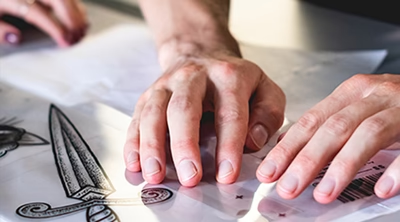Plastisol Heat Transfer: The Ultimate Guide to Screen Printers
Speed, flexibility, and quality are important business in the custom apparel industry. Whether you print from your garage alone or you have a successful screen printing business, these plastisol heat transfers can be your savior. It enables you to pre-print artwork and apply it later on — the best for on-demand orders, bulk orders management, or selling transfer-ready artwork for resale.
If you ever wanted to know how to make screen print transfers, or what kind of screen print transfer paper to use, then you have come to the right place because this tutorial has you covered. We will show you how, why, and some best practices for making great plastisol heat transfers that look and feel like a pro did them.
What is a Plastisol Heat Transfer?
A plastisol heat transfer is a screen printing process in which you screen print your image on to transfer paper with plastisol ink, let it dry (but not cure) and then apply the pattern to a shirt with a heat press when you want to. With this type of process, unlike direct-to-garment printing, you can create and have stock transfers in bulk so production is faster and more convenient.
After transferring, the result is identical to screen printed directly onto the material — only now you have greater versatility and less waste.
Why Use Plastisol Heat Transfers?
Screen printers are incorporating transfer paper for screen printing rather than printing directly onto shirts for a variety of reasons:
More Quick Turnaround Times – Pre-made transfers allow you to complete orders quickly, especially reprints.
Less Waste of Inventory – Print once, press on demand. No inventory of every size and color to pre-stock.
Improved Print Consistency – Make consistent, high-quality prints without re-burning screens or re-loading presses for second and subsequent use.
Increased Product Options – Sell printed designs for festivals, holiday promotions, or sell custom transfers to other businesses.
How to Make Screen Print Transfers
Creating screen print transfers with plastisol ink is a straightforward process, but it requires the right tools and a bit of practice. Here's a step-by-step guide:
1. Gather Your Supplies You’ll need:
Plastisol ink
Screen print transfer paper (also called heat transfer paper for screen printing)
A screen printing press
Heat press (not an iron!)
Squeegee
Curing unit (like a flash dryer or conveyor)
Make sure you use high-quality screen print transfer paper that is specially designed to release the ink sufficiently when heat is applied.
2. Burn Your Screen
Start by creating your artwork and burning your screen the same way you would do for a normal screen printing job. Make sure your stencil is crisp, and your mesh count is proportionate to the level of detail in your artwork.
3. Print Onto Transfer Paper
Instead of printing onto a shirt, you’ll print your design onto the transfer paper for screen printing. Use a slightly heavier ink deposit to ensure enough plastisol transfers to the fabric during heat pressing. Print each color one at a time and let each layer gel before adding the next.
Pro Tip: Add a heat transfer adhesive powder if more hold is desired. This can cause your print to stick better to some fabrics.
4. Cure the Ink (But Not Completely)
This is an important step. Ink must gel — not cure — on paper. Flash dry or move to a conveyor at about 220°F (105°C). Avoid overcuring, and the design will not adhere well when later heat pressed onto fabric.
5. Store or Use Your Transfers
Once you have prepared the transfer sheets, you can use them right away or store them for later use in a dry and cool place. You only need to store them flat and not expose them to too much humidity.
6. Heat Press Application
When ready, lay your design ink-side down on the garment. Heat it up with a heat press — usually about 325°F (163°C) for 10–15 seconds with medium pressure. Allow it to cool a bit, and then remove the paper.
You now have a clean, pro-quality print — just like a direct screen print.
Selecting the Right Screen Print Transfer Paper
Not all that claims "transfer paper" is created equal. Use plastisol transfer papers specifically designed for this purpose. These will leave the ink pure and easily bond with heat pressing.
Avoid using standard transfer papers, or those designed for sublimation printing or inkjet printing — they'll do nothing at all for plastisol inks and will ruin your prints.
Avoid the following pitfalls:
Overcuring the ink: This will prevent it from adhering on transfer.
Bad paper: Always use premium quality transfer paper to be used for screen printing.
Not pressing hard enough: Ensure your heat press is well calibrated.
No test presses: Always test press one transfer prior to completing the entire run.
If you find yourself needing a smarter method of fulfilling print orders, to accelerate output, or even to add more products to your lineup, plastisol heat transfers are certainly an option to explore. Having learned about the technique of making screen print transfers, you can print on demand, send orders out sooner, and reduce wastage in production.
Regardless of whether you're screen printing for a client or creating your own clothing line, this process will allow you to work smarter — not harder.
Need a step-by-step tutorial on screen printing with plastisol transfers? Check out our extensive guide here:


.webp)

Comments
Post a Comment